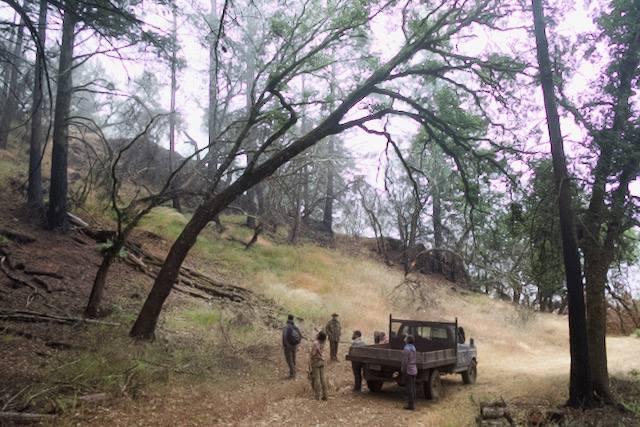Post-fire ecology and future prescribed burns: A visit with Fire Forward
We had the good fortune to spend a morning with the team from Audubon Canyon Ranch’s Fire Forward program —Dr. Sasha Berleman, Brian Peterson, and Garrett Gradillas — walking the land to observe post-fire recovery of our diverse ecology, imagine future prescribed burns, and identify fun fire following plants.
Starting at our community building, Rick shared a map of the eastern portion of Monan’s Rill to describe where we would walk, near the east edge of the property to consider where a containment line could be put in for future prescribed fire on the land once the vegetation has grown back enough to warrant prescribed burns. We shuttled up to the top of the land (referred to as Narnia) in the back of the truck, and made our way downhill on foot from there.
As we drove to Narnia, we passed through the 6-acre area that was successfully burned in a prescribed fire led by Sasha in June 2019, fifteen months before the Glass Fire. (Incidentally, our prescribed burn is mentioned in today’s in-depth Living with Fire article in Bay Nature magazine). This area is one of the healthiest among the 414 acres that Monan’s Rill stewards, as the intense flames of the Glass Fire burned all around it but did not enter because of the fuel reduction that was achieved through the prescribed fire. Brian was quick to point out that this is not always the case with land that has had a prescribed burn in advance of a wildfire, but it is a beautiful visual example of one of the beneficial effects that prescribed fire can have.

Outside of those six healthy and green acres, the severity of the Glass Fire is abundantly evident. Fir trees are torched from bottom to top. However, hardwood trees are beginning to sprout back from the bases, and shrubs and herbaceous plants are beginning to germinate an grow on the forest floor, now that they are no longer shaded by firs and the ground is not covered in the thick layer of duff created by fir needles.

As we traversed the contours of the arbitrary linear property-line boundary, we encountered a matrix of different soils and ecologies, evident even through the massive damage of the wildfire.

On our walk, we also stopped to observe and identify many species, including fire-following native flowers like the ground rose and wiry snapdragon.


As we moved from the forest into the chaparral area, we talked about what kind of plan for prescribed burns would best support the ecology and the safety of the community in the face of future wildfires which we know are inevitable. The chaparral likely will not be ready to burn for 5-10 years, depending on how quickly it regenerates. The chamise is vigorously sprouting back, but the manzanita species that is prevalent at Monan’s Rill does not resprout. Its seeds are stimulated to germinate by fire, though the seedlings are only an inch or so tall at this point, so they will take a while to become mature plants. Moving forward, Sasha suggested prescribed burns in this area every 10-15 years. More frequent burns in chaparral can kill the vegetation permanently and convert the area to grassland, often dominated by invasive species.

For a lot of the area we walked, the approach Sasha and Brian recommend is “wait and see” — nobody can say for certain exactly how the landscape will regenerate, what species will show up, and how. In the meantime, we have our work cut out for us reducing the fuel load in the area where our homes once stood (and will eventually be rebuilt) by clearing dead manzanita and other brush that was killed but not consumed by the wildfire. We can also prepare to eventually build control lines for prescribed fire by cutting dead trees near the perimeter of future burn areas so they don’t become hazard trees that are more complicated to remove later. And several of us will continue to participate in prescribed burns on other private and public lands so we have more skills and experience to apply to bringing good fire to this land when the time is right.


